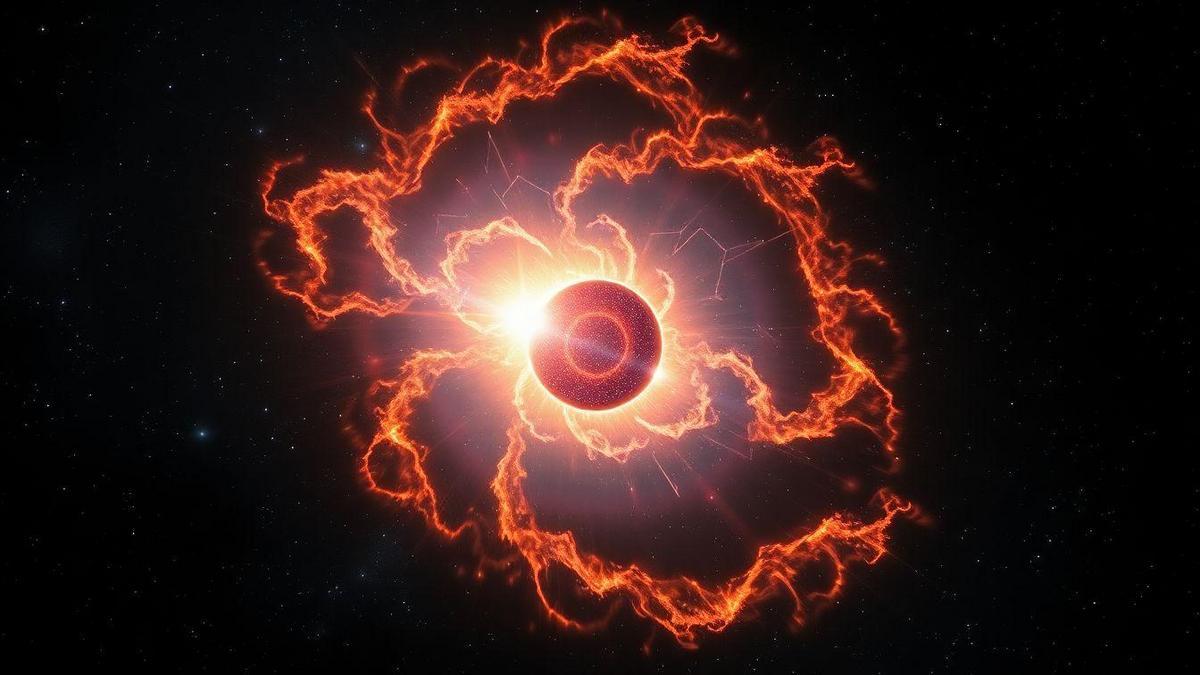
Magnetars are one of the most fascinating and enigmatic phenomena in the universe. They are neutron stars with intensely strong magnetic fields—up to a million billion times stronger than Earth’s magnetic field. These cosmic objects result from supernova explosions and represent a final stage in the evolution of massive stars. The study of magnetars not only helps us better understand the physics of stars but also provides insights into the nature of gravity and matter under extreme conditions.
In addition to their magnetic strength, magnetars are known for their gamma-ray bursts—the most energetic events in the universe. These bursts can be detected billions of light-years away and are a valuable source of information about the structure and dynamics of the cosmos. Research on magnetars is constantly evolving, and new discoveries are being made as observational technology advances, allowing scientists to explore these cosmic magnets in ways that were once unimaginable.
How Magnetars Work: The Most Powerful Magnets Known
Magnetars operate through a complex process involving matter fusion and magnetic field dynamics. When a massive star exhausts its nuclear fuel, it collapses under its own gravity, resulting in a supernova explosion. The remaining core, which becomes a neutron star, is composed mostly of neutrons and has an extremely high density. During this collapse, the original star’s magnetic field becomes intensified, resulting in extraordinarily powerful magnetic fields.
These magnetic fields are so intense that they can influence nearby matter in unusual ways. Radiation emitted by a magnetar may become polarized, and the magnetic field’s intensity can affect the behavior of charged particles around it. Additionally, the magnetar’s rapid rotation—sometimes thousands of times per second—also plays a crucial role in its dynamics, creating an extremely energetic and chaotic environment.
Magnetars are notable for their gamma-ray bursts, which occur due to sudden changes in their magnetic fields. These events, known as outbursts, can release an immense amount of energy in a short period, triggered by magnetic instabilities that cause the stored energy to be explosively released. This energy release can result in bursts of radiation detectable across vast distances.
The interaction between rotation, magnetic field, and internal structure of the magnetar is an active area of research. Scientists aim to understand how these factors combine to influence magnetar behavior over time. This research not only enhances our understanding of magnetars but may also provide insights into the fundamental physics that governs the universe.

Advantages of Studying Magnetars: The Most Powerful Magnets Known
Studying magnetars offers a series of advantages beyond scientific curiosity. Firstly, these cosmic objects are natural laboratories for testing physical theories under extreme conditions. The physics of magnetars—especially regarding their intense magnetic fields and matter density—can provide valuable information about matter in states that cannot be replicated in Earth-based laboratories.
Secondly, magnetars deepen our understanding of stellar evolution and supernova dynamics. By observing how magnetars form and evolve, scientists can gain clearer insights into the processes that govern the life and death of stars. This is fundamental to astrophysics, as stars play a crucial role in the formation of elements and the evolution of the universe.
Moreover, the gamma-ray bursts associated with magnetars are a source of highly energetic radiation that can be used to study the cosmic environment. These bursts can serve as “beacons” to investigate the structure of spacetime and the expansion of the universe. The detection and analysis of these bursts can provide clues about the distribution of dark matter and dark energy—two of the most mysterious components of the cosmos.
Lastly, magnetars have practical implications for modern astrophysics. Studying these cosmic magnets can lead to advances in detection and observation technologies, as well as in data analysis methods. As scientists develop new tools to study magnetars, these methods can be applied to other areas of astrophysical research, expanding our overall understanding of the universe.
How to Identify and Observe Magnetars: The Most Powerful Magnets Known
Identifying and observing magnetars is a challenge that requires advanced technology and a deep understanding of astrophysical phenomena. Scientists use several approaches to detect and study these fascinating objects.
-
Using gamma-ray telescopes: Telescopes designed to detect gamma rays are essential for identifying magnetars. These instruments can capture radiation emitted during explosions and outbursts, allowing scientists to locate and study these distant objects.
-
Analyzing intense magnetic fields: Measuring and analyzing the magnetic fields around magnetars is crucial. Scientists use polarization and spectroscopy techniques to understand how these fields interact with surrounding matter and radiation.
-
Monitoring supernova explosions: Observing supernovae can provide clues about the formation of magnetars. By studying the characteristics of the explosions, astrophysicists can infer the presence of a forming magnetar.
-
Studying emitted electromagnetic radiation: Magnetars emit radiation across various ranges of the electromagnetic spectrum. Analyzing this radiation helps scientists better understand the composition and dynamics of magnetars.
-
Observing associated astrophysical phenomena: The interaction of magnetars with nearby cosmic objects, such as nearby stars and gas clouds, can generate observable phenomena. Studying these interactions provides additional information about magnetars.
-
Researching cosmic energy output: The energy released during magnetar outbursts is a key area of active research. Scientists study this energy to better understand the properties of magnetars and their impact on the cosmic environment.
These combined approaches allow scientists to effectively identify and study magnetars. As technology advances, new techniques and instruments are being developed, promising to deepen our understanding of these cosmic magnets even further.
Challenges in Studying Magnetars: Unlocking the Secrets of Extreme Physics
Despite the growing interest in magnetars, studying them presents numerous challenges due to their rarity, distance, and the extreme environments in which they exist. Only a few dozen confirmed magnetars have been identified to date, making them relatively rare objects in the cosmic landscape. This scarcity limits the amount of observational data available for scientists to analyze.
One major obstacle is their unpredictability. Magnetars can remain dormant for long periods and suddenly emit intense bursts of radiation without warning. Capturing these brief and powerful outbursts requires continuous monitoring and rapid-response observation systems, which are often difficult to coordinate on a global scale.
Another challenge is the interference of interstellar matter. The radiation emitted by magnetars can be absorbed or scattered by gas and dust between the object and Earth, complicating the detection and analysis of their true emissions. Advanced instruments and data correction techniques are needed to filter out these distortions and extract accurate information.
Additionally, modeling the internal physics of magnetars is extremely complex. The behavior of matter under such intense magnetic fields and gravitational forces is not fully understood and often requires the development of new theoretical frameworks. This makes simulations and predictions particularly difficult, especially when trying to match observational data with models.
Despite these difficulties, advancements in telescope technology, data analysis, and international collaboration are helping researchers overcome these barriers. Each new observation of a magnetar brings scientists one step closer to understanding the fundamental laws of nature under the most extreme conditions known in the universe.

Enjoyed Learning About Magnetars: The Most Powerful Magnets Known?
Magnetars are undoubtedly one of the most intriguing phenomena in the cosmos, and their study continues to reveal secrets about the fundamental physics of the universe. Every new discovery about these powerful magnets brings us closer to understanding the nature of matter and energy under extreme conditions.
If you’re interested in magnetars and want to learn more about these fascinating cosmic objects, keep exploring the wonderful world of astrophysics. There’s so much more to discover and understand about the universe we live in!
Frequently Asked Questions
What are magnetars: the most powerful magnets known?
Magnetars are neutron stars with extremely strong magnetic fields. They are the most magnetic objects in the universe!
How do magnetars form?
They form after a supernova explosion. The core collapses and creates a neutron star with an intense magnetic field.
What effects do magnetars have on Earth?
Even thousands of light-years away, magnetars can interfere with radio signals and even cause auroras. Impressive, isn’t it?
Can magnetars explode?
Yes! They can release enormous X-ray explosions, called “glitches,” which are incredibly powerful!
Where can we find magnetars in the universe?
They are scattered across the galaxy. Some are millions of light-years away, but others might be much closer than you think!





